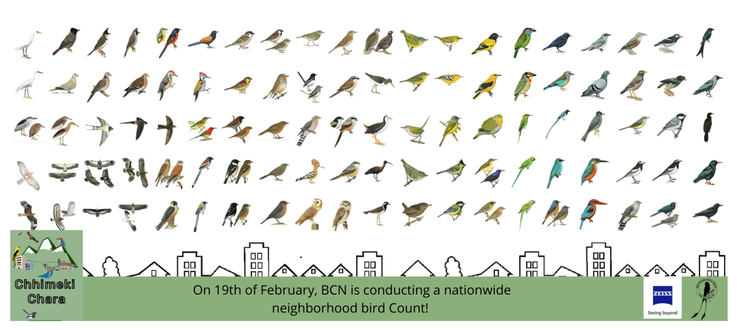- Nepali bird enthusiasts used a mobile app in February to record sightings of birds in their neighborhoods, in an initiative inspired by the Great Backyard Bird Count.
- In addition to being a tool for citizen engagement, initiatives like this help scientists assess bird population across the country, conservationists say.
- The success of the February campaign has encouraged organizers to conduct another round in May.
KATHMANDU — Hundreds of bird lovers in Nepal, who would otherwise have been enjoying the spring weather visiting the various bird-watching sites around the country, stayed home in the second week of February spending time on their mobile phones.
They looked for birds in their own neighborhoods, counted them and uploaded the information to the Chhimeki Chara (“neighborhood bird”) app created recently by Bird Conservation Nepal (BCN), a partner of BirdLife International, for this year’s bird count.
“We came up with the idea to use a mobile phone app after being inspired by the Great Backyard Bird Count, which takes place every year worldwide from February 18-21,” said Arati Nepali from BCN.
Launched in 1998 in the U.S. by the Cornell Lab of Ornithology and National Audubon Society, the aim of the Great Backyard Bird Count is to bring together people for the love of birds. Over four days, it invites people to watch and count as many birds as possible. These observations, according to the organizers, help scientists better understand global bird populations before one of their annual migrations.
According to their website, people from around the world observed 7,099 species of birds in 253 sub-regions during the count period. Colombia topped the list with 1,240 species, Ecuador 1,039 and India 1,022.
“It was the first time that we used the concept in Nepal. Our objective was to help people enjoy birds, generate insights for the public, support bird conservation, make neighborhoods bird-friendly and generate new ideas,” Nepali said.

According to BCN data, around 1,500 people from 55 of 78 districts in Nepal downloaded the app. Of these, 432 users submitted data on around 160 species. Around 53% of the data was received from outside Kathmandu Valley, Nepal’s main urban center.
The most common birds reported by users were the rock pigeon (Columba livia, reported by 70% of users), house crow (Corvus splendens, 57%) and common myna (Acridotheres tristis, 50%). Species such as the Oriental magpie robin (Copsychus saularis), black drongo (Dicrurus macrocercus), and black kites (Milvus migrans) also made the top 10.
“The app was easy to use. We provided pictures of 100 of the most common birds found in Nepal. But users identified 160 species,” Nepali told Mongabay.
Nepali and her team had approached BCN members, conservationists, and students from various schools and universities across the country to encourage them to use the app and contribute to the conservation of birds.
However, the information generated was not uploaded into the Great Backyard Bird Count database. data into the Great Backyard Count system,” Nepali said. “We are just borrowing their concept to raise awareness.”
Bird lovers in Nepal also had to option to participate in the Great Backyard Bird Count using the eBird platform. According to the website, 246 species from Nepal were recorded on the platform by 29 people.
According to BirdLife International, 820 species of birds have been recorded in Nepal. Nepali ornithologists, however, estimate the number to be around 889. As of 2017, around 168 species have been classified as threatened.
Unplanned urbanization and development of infrastructure such as roads, airports and power lines are seen as major threats to birds in Nepal.
“Although Nepal is home to so many bird species, people in the urban centers don’t know much about it,” said Hum Gurung, regional project manager for forest governance at BirdLife International.
“It is either the rich who have time to observe birds or the poor who work in the fields who know about birds. The people in the middle don’t know much about birds,” he added.
Initiatives such as the Chhimeki Chara app help raise awareness among this demographic of the birds in their midst, he said.
Gurung, who’s role at BirdLife International also covers Southeast Asia and the Pacific, said he has also observed the success of similar mobile phone apps in bird conservation in Malaysia and Singapore.
Conservationists say such initiatives can go beyond citizen engagement and help scientists assess bird populations. “When we look at the population of birds, we try to identify trends rather than come up with exact numbers,” said conservationist Narendra Man Singh Pradhan. “That’s where initiatives like this come in.”
Following the success of the February count, BCN plans to conduct a summer bird count in May using the same app. “We hope that more people download the app and help conserve birds in the country,” Nepali said.
Feedback: Use this form to send a message to the author of this post. If you want to post a public comment, you can do that at the bottom of the page.
Banner Image: Australian ambassador to Nepal Felicity Volk takes part in the neighborhood bird count in Kathmandu. Image courtesy BCN
Related audio from Mongabay’s podcast: Hear this reporter discuss a range of bird conservation issues in Nepal, listen here:
